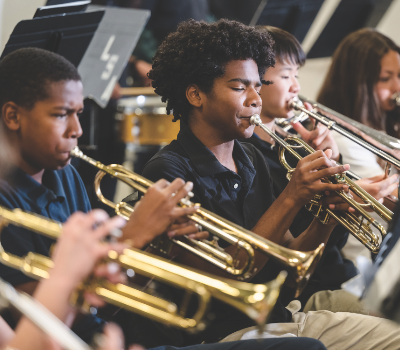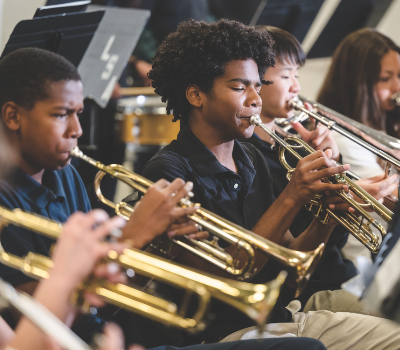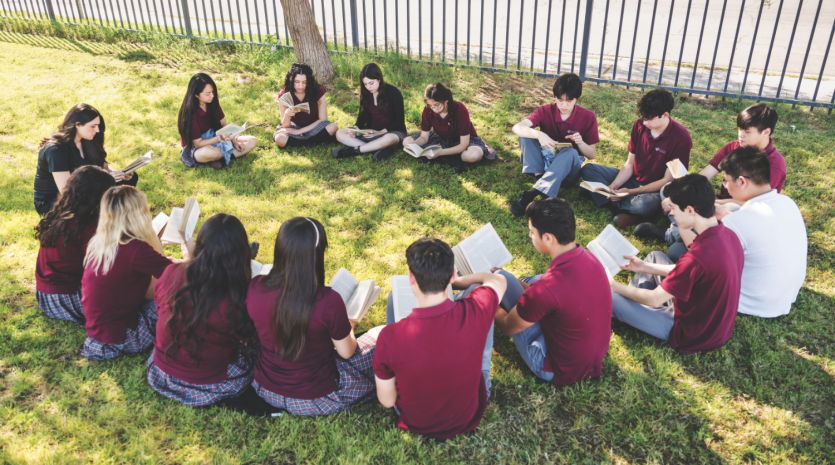The establishment of Adventist education began in the late 1800s after the foundation of the Seventh-day Adventist denomination had been set and its leaders began to look past the immediate structure of the church—both literally and figuratively.1 As the story goes, a group of church elders gathered for a meeting one evening to discuss the future of the fledgling church and its vision. At that point, evangelists had already been dispatched to share their faith across the world, and hospitals, another strong emphasis of the Seventh-day Adventist Church, were being established. “What now?” these church elders purportedly asked themselves. “Where should we direct our resources, our time, our efforts?” Should the church invest in more missionary work abroad? Publishing houses? Farmland?2



After some murmured discussion, a clear voice rang out: “What can we take to heaven with us? Not our clothes or our homes or any worldly belongings. The only thing we can take with us is our children. And so there is our answer; we must invest in our children.” And that, as legend has it, was the start of the Adventist educational system.3 More than a hundred years later, as of this writing, there are approximately 600 Adventist elementary schools and 50 high schools in the North American Division, serving approximately 50,000 students.4 Seventh-day Adventist schools in America are structured a little differently from their public school counterparts. Adventist elementary schools, for instance, run from transitional kindergarten through eighth grade, with the seventh and eighth grades sometimes called “junior high.” That’s not to be confused with junior academies, which go up to tenth grade, and senior academies, which are secondary or high schools serving students in grades nine through twelve. Many Adventist elementary schools are considered “small schools,” housing three or more grades in a single classroom. There are, in fact, more than a hundred one-room Adventist schools in North America with a single teacher and up to 20 students of all different grade levels.5



Another type of campus is the boarding academy, an institution that has been a part of the Adventist education landscape for more than a hundred years. For example, the school that would eventually become Maplewood Academy in Hutchinson, Minnesota, was founded in 1888 and continues to provide a high-quality education for its students today.6 These schools offer students the unique opportunity to live on campus in dormitories while attending classes during the day.
While there are differences from campus to campus, a common thread that runs through all Adventist schools is a deep and abiding commitment to wholistic education. Rooted in a biblical worldview, Adventist education seeks to develop not only a child’s mind but also their body and spirit. This wholistic perspective is evidenced in teacher qualifications, extracurricular choices, and academic offerings.7
Service to God and humanity, for instance, is a strong component in most Adventist schools; they often emphasize service in the curriculum and will usually have a requirement for community service hours in their handbooks. Mission trips are often extracurricular opportunities, especially at the high school level. These outreach endeavors can range from single-day outings to neighboring communities to clean up trash to weeklong international trips to help build a church or volunteer at an orphanage.8



Another theme in Adventist educational philosophy is that formal education should also be practical, useful, and relevant.9 Adventist schools offer many work-related and practical applications in the school day. Loma Linda Academy, with its robust TIE (Technology, Innovation, and Engineering) program, is just one example.10 Many academies have hung on to such courses as woodworking, home economics, and auto mechanics long after their public school counterparts discontinued them.11 For decades, most Adventist educational institutions had a dairy, farm, or other agricultural or service industry on their property where their students worked for half the day.
In addition to service and practical education, another common component of Adventist schools is a strong fine arts program. Following the framework of wholistic development as well as the belief that God uniquely created all individuals and gifted each one with special talents, Adventist schools make music and the arts a high priority within their curriculum despite budgetary constraints.12 Students who have attended Adventist schools from kindergarten through 12th grade will likely have sung in a choir and learned to play one or two musical instruments. But beyond just classroom music and the requisite Christmas program, this musical training is often taken off campus and shared with the community. School musical ensembles, such as choirs or wind symphonies, will often perform for nursing homes and area churches. Similar to the mission trip, music tours at the secondary level also often involve teachers leading their ensembles on an annual trip designed to showcase their music in a variety of venues in different locales. These tours always contain an evangelistic or outreach underpinning, giving evidence once more of the close tie between church and school.13

As these examples demonstrate, Adventist education focuses on the student's wholistic development. This does not mean, however, that the academic program is sacrificed for these other educational offerings. Rather, a recent study found that students in Adventist schools, when compared to national norms, were above average in academic achievement. Moreover, the longer students stayed in the Adventist educational system, the higher their scholastic achievements.14
The curriculum found in Adventist schools is chosen within the same context and for the same reasons as all the other components of the school system—it is meant to be relevant to the beliefs of the Adventist Church and fall within a biblically based framework. Educators in Adventist schools may teach out of the same textbooks as their public school counterparts in some subjects, whereas in other areas, such as science or Bible, the education committee for the North American Division writes and publishes its own textbooks.15

This singular purpose to educate students through a biblical worldview and in a God-loving, service-first environment has certainly made its mark. What began as the hopes and dreams of the founding members of the Seventh-day Adventist Church has grown into the world’s second-largest parochial school system.16
_____________________________
Aimee Leukert is an associate professor of curriculum and instruction at La Sierra University in Riverside, California. This article has been taken with permission from her book Thriving: 31 Stories on the Impact of Adventist Education, available from adventistbookcenter.com.
- George R. Knight, “Why Have Adventist Education?” Journal of Adventist Education 67, no. 5 (summer 2005), pp. 6-9.
- Nedd Brown, conversation with author, Dec. 12, 2002.
- Brown, conversation with author.
- “2022-2023 Adventist Education Statistics,” Adventist Education, https://v1.adventisteducation.org/stat.html (accessed April 13, 2023).
- “2022-2023 Adventist Education Statistics.”
- “Our History,” Maplewood Academy, https://www.maplewoodacademy.org/our-history (accessed April 13, 2023).
- Knight, “Why Have Adventist Education?” pp. 6-9.
- George H. Akers, “‘Proper Education,’” Journal of Adventist Education 52 (Oct.-Nov. 1989), pp. 8-11, 36-37.
- Akers, p. 37.
- Jay Linthicum, “The TIE Program: Loma Linda Academy’s Educational Phenomenon,” Spectrum, Aug. 11, 2018, https://spectrummagazine.org/news/tie-program-loma-linda-academys-educational-phenomenon/.
- Raymond Carson, “Practical Skills for 21st-Century Students,” Journal of Adventist Education 72, no. 4 (April/May 2010), pp. 38-46.
- Brown, conversation with author.
- Kristian Leukert, conversation with author, Sept. 7, 2015.
- Jerome Thayer and Elissa Kido, “CognitiveGenesis (CG): Assessing Academic Achievement and Cognitive Ability in Adventist Schools,” abstract, Journal of Research on Christian Education 21, no. 2 (2012), pp. 99-115, https://bit.ly/48QQiat.
- “Adventist Education Curriculum,” Adventist Education, https://bit.ly/3OtSM6w (accessed April 25, 2023).
- “The Adventist Difference,” Adventist Education, https://adventisteducation.org/who (accessed April 17, 2023).
Pujante: el desarrollo integral de la educación adventista
Por Aimee Saesim Leukert
El establecimiento de la educación adventista comenzó a finales de 1800, después de que se estableció la fundación de la denominación Adventista del Séptimo Día y sus líderes comenzaron a ver más allá de la estructura inmediata de la iglesia, tanto literal como figurativamente.1 Según cuenta la historia, un grupo de ancianos de la iglesia se reunió una noche para discutir el futuro de la incipiente iglesia y su visión. En ese momento ya se habían enviado evangelistas para compartir su fe en todo el mundo, y se estaban estableciendo hospitales, otro fuerte énfasis de la Iglesia Adventista del Séptimo Día. «¿Y ahora qué?», se preguntaron supuestamente esos ancianos de la iglesia. «¿Hacia dónde debemos dirigir nuestros recursos, nuestro tiempo, nuestros esfuerzos?» ¿Debería la iglesia invertir en más obra misionera en el extranjero? ¿Editoriales? ¿Tierras de cultivo?2



Después de una breve discusión, una voz clara resonó: «¿Qué podemos llevar al cielo con nosotros? Ni nuestra ropa, ni nuestras casas, ni ninguna pertenencia mundana. Lo único que podemos llevar con nosotros son nuestros hijos. Ahí está nuestra respuesta; debemos invertir en nuestros hijos». Eso, según cuenta la leyenda, fue el comienzo del sistema educativo adventista.3 Más de cien años después, al momento de escribir este artículo, hay aproximadamente 600 escuelas primarias adventistas y 50 escuelas secundarias en la División Norteamericana, que sirven a aproximadamente 50.000 estudiantes.4 Las escuelas adventistas del séptimo día en Estados Unidos están estructuradas de manera un poco diferente a sus contrapartes de las escuelas públicas. Las escuelas primarias adventistas, por ejemplo, funcionan desde el jardín de infantes hasta el octavo grado, y los grados séptimo y octavo a veces se llaman «junior high». Eso no debe confundirse con las junior academies, que van hasta el décimo grado, y las senior academies, que son high schools que atienden a estudiantes de noveno a duodécimo grado. Muchas escuelas primarias adventistas son consideradas «escuelas pequeñas», que albergan tres o más grados en un salón de clases. De hecho, hay más de cien escuelas adventistas de un solo salón en Norteamérica con solo un maestro y hasta 20 estudiantes de todos los niveles de grado.5



Otro tipo de campus es el internado, una institución que ha sido parte del panorama educativo adventista durante más de cien años. Por ejemplo, la escuela que eventualmente se convertiría en Maplewood Academy en Hutchinson, Minnesota, fue fundada en 1888 y continúa brindando una educación de alta calidad a sus estudiantes.6 Esas escuelas ofrecen a los estudiantes la oportunidad especial de vivir en los dormitorios del campus mientras asisten a clases durante el día.
Si bien hay diferencias de un campus a otro, un hilo común de todas las escuelas adventistas es un compromiso profundo y duradero con la educación integral. Arraigada en una cosmovisión bíblica, la educación adventista procura desarrollar no solo la mente del estudiante, sino también su cuerpo y su espíritu. Esa perspectiva holística se evidencia en las cualificaciones de los maestros, las opciones extracurriculares y las ofertas académicas.7
El servicio a Dios y a la humanidad, por ejemplo, es un componente sólido en la mayoría de las escuelas adventistas; a menudo enfatizan el servicio en el plan de estudios y, por lo general, tendrán un requisito de horas de servicio comunitario en sus prospectos. Los viajes misioneros son a menudo oportunidades extracurriculares, especialmente a nivel de high school. Esas actividades pueden variar desde salidas de un solo día a las comunidades vecinas para limpiar la basura hasta viajes internacionales de una semana para ayudar a construir una iglesia o ser voluntarios en un orfanato.8



Otro tema de la filosofía educativa adventista es que la educación formal también debe ser práctica, útil y relevante.9 Las escuelas adventistas ofrecen muchas aplicaciones prácticas y relacionadas con el trabajo en la jornada escolar. Loma Linda Academy, con su sólido programa TIE (Tecnología, Innovación e Ingeniería), es solo un ejemplo.10 Muchas academias se han aferrado a cursos como carpintería, economía doméstica y mecánica automotriz mucho después de que sus contrapartes de las escuelas públicas los suspendiesen.11 Durante décadas, la mayoría de las instituciones educativas adventistas tenían una industria lechera, granja u otra industria agrícola o de servicios en su propiedad, donde sus estudiantes trabajaban la mitad del día.
Además del servicio y la educación práctica, otro componente común de las escuelas adventistas es un sólido programa de bellas artes. Siguiendo el marco del desarrollo integral, así como la creencia de que Dios creó de manera especial a todos los individuos y dotó a cada uno con talentos especiales, las escuelas adventistas hacen de la música y las artes una alta prioridad dentro de su plan de estudios a pesar de las limitaciones presupuestarias.12 Los estudiantes que han asistido a escuelas adventistas desde el jardín de infantes hasta el duodécimo grado probablemente habrán cantado en un coro y aprendido a tocar uno o dos instrumentos musicales. Pero más allá de la música en el aula y el programa navideño requerido, esa formación musical a menudo se lleva fuera del campus y se comparte con la comunidad. Los conjuntos musicales escolares, como los coros o sinfonías para viento, a menudo se presentan en hogares de ancianos e iglesias de la localidad. Al igual que en viajes misioneros, las giras musicales en el nivel de high shcool también suelen involucrar a los maestros que dirigen a sus conjuntos en un viaje anual diseñado para mostrar su música en una variedad de lugares. Esas giras siempre contienen un trasfondo evangelístico, lo que evidencia una vez más del estrecho vínculo entre la iglesia y la escuela.13

Como demuestran esos ejemplos, la educación adventista se centra en el desarrollo integral del estudiante. Eso no significa, sin embargo, que se sacrifique el programa académico por esas otras actividades educativas. Más bien, un estudio reciente encontró que los estudiantes de las escuelas adventistas, en comparación con las normas nacionales, estaban por encima del promedio en rendimiento académico. Además, cuanto más tiempo permanecían los estudiantes en el sistema educativo adventista, mayores eran sus logros académicos.14
El currículo que se encuentra en las escuelas adventistas se elige dentro del mismo contexto y por las mismas razones que todos los demás componentes del sistema escolar: está destinado a ser relevante para las creencias de la Iglesia Adventista y encajar dentro de un marco basado en la Biblia. Los educadores de las escuelas adventistas pueden enseñar con los mismos libros de texto que sus contrapartes de las escuelas públicas en algunas materias, mientras que en otras áreas, como ciencia o Biblia, el comité de educación de la División Norteamericana escribe y publica sus propios libros de texto.15

Ese singular propósito de educar a los estudiantes a través de una cosmovisión bíblica y en un ambiente de amor a Dios y de servicio al prójimo ciertamente ha dejado su huella. Lo que comenzó como las esperanzas y los sueños de los miembros fundadores de la Iglesia Adventista del Séptimo Día se ha convertido en el segundo sistema escolar parroquial más grande del mundo.16
_____________________________
Aimee Leukert es profesora asociada de currículo e instrucción en La Sierra University en Riverside, California. Este artículo ha sido tomado con permiso de su libro Thriving: 31 Stories on the Impact of Adventist Education disponible en adventistbookcenter.com.
- George R. Knight, “Why Have Adventist Education?” Journal of Adventist Education 67, no. 5 (summer 2005), pp. 6-9.
- Nedd Brown, conversación con la autora, Dec. 12, 2002.
- Brown, conversación con la autora.
- “2022-2023 Adventist Education Statistics,” Adventist Education, https://v1.adventisteducation.org/stat.html (accessed April 13, 2023).
- “2022-2023 Adventist Education Statistics.”
- “Our History,” Maplewood Academy, https://www.maplewoodacademy.org/our-history (accessed April 13, 2023).
- Knight, “Why Have Adventist Education?” pp. 6-9.
- George H. Akers, “‘Proper Education,’” Journal of Adventist Education 52 (Oct.-Nov. 1989), pp. 8-11, 36-37.
- Akers, p. 37.
- Jay Linthicum, “The TIE Program: Loma Linda Academy’s Educational Phenomenon,” Spectrum, Aug. 11, 2018, https://bit.ly/4atmMb6.
- Raymond Carson, “Practical Skills for 21st-Century Students,” Journal of Adventist Education 72, no. 4 (April/May 2010), pp. 38-46.
- Brown, conversación con la autora.
- Kristian Leukert, conversación con la autora, Sept. 7, 2015.
- Jerome Thayer and Elissa Kido, “CognitiveGenesis (CG): Assessing Academic Achievement and Cognitive Ability in Adventist Schools,” abstract, Journal of Research on Christian Education 21, no. 2 (2012), pp. 99-115, https://bit.ly/48QQiat.
- “Adventist Education Curriculum,” Adventist Education, https://bit.ly/3OtSM6w (accessed April 25, 2023).
- “The Adventist Difference,” Adventist Education, https://adventisteducation.org/who (accessed April 17, 2023).






